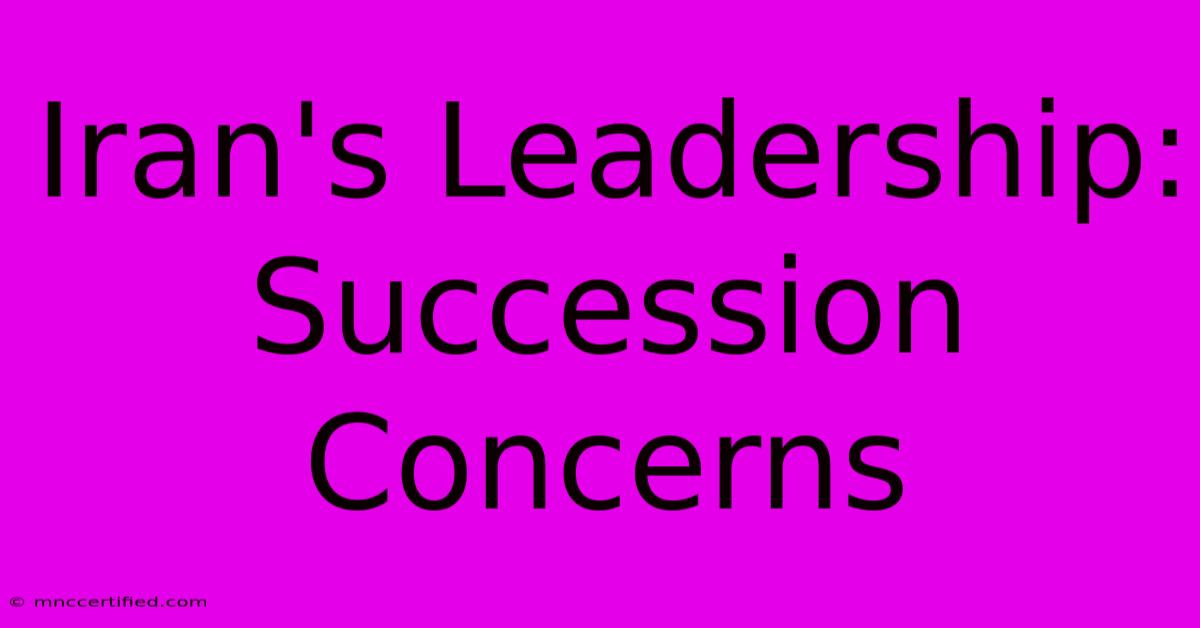Iran's Leadership: Succession Concerns

Table of Contents
Iran's Leadership: Succession Concerns and the Future of the Islamic Republic
Iran's political system, a unique blend of theocratic and republican elements, is facing a critical juncture: the looming question of leadership succession. The Supreme Leader, Ayatollah Ali Khamenei, is now 83 years old and his health has become a significant concern, triggering widespread speculation about the future of the Islamic Republic. This uncertainty carries profound implications for Iran's domestic politics, regional influence, and its relationship with the international community. Understanding the complexities surrounding this issue is crucial for anyone seeking to grasp Iran's future trajectory.
The Structure of Power: Understanding the Succession Process
The Iranian political system is structured around two key figures: the Supreme Leader and the President. While the President, currently Ebrahim Raisi, holds significant executive power, the Supreme Leader is the ultimate authority. He controls the military, appoints key judges, and has the final say on all major policy decisions. The process of selecting a new Supreme Leader is shrouded in secrecy, lacking clearly defined rules. It's largely up to the Assembly of Experts, a body of 88 clerics elected by the people, to choose a successor. However, the Assembly's decision is heavily influenced by the existing power structures within the clerical establishment.
Challenges in Identifying a Suitable Successor
Identifying a successor is fraught with challenges. The next Supreme Leader needs to possess several crucial qualities:
- Religious Authority: He must be a highly respected Grand Ayatollah, commanding the legitimacy and authority necessary to lead the country.
- Political Acumen: He needs strong political skills to navigate the complex web of political factions and maintain stability.
- Acceptance by the Guard: The Islamic Revolutionary Guard Corps (IRGC), a powerful military force, holds significant influence and its acceptance of the new leader is vital.
- Balancing Hardline and Pragmatic Views: Successfully navigating the internal political landscape will require a delicate balance between appeasing hardline factions and potentially engaging in some degree of pragmatic diplomacy.
The absence of a clear heir apparent, combined with the diverse factions within the clerical establishment, fuels speculation and potential for power struggles following Khamenei's death or incapacitation.
Potential Scenarios and their Implications
Several scenarios are possible following Khamenei's departure:
- A Smooth Transition: A pre-selected successor, potentially someone already holding a prominent position within the clerical hierarchy, could smoothly assume leadership. This scenario, though unlikely given the lack of transparency, would minimize disruption.
- A Contested Succession: Different factions vying for power could lead to intense behind-the-scenes maneuvering and even open conflict. This could destabilize the country and impact regional security.
- Collective Leadership: A council of senior clerics might temporarily assume leadership, but this solution is likely to be short-lived and prone to internal divisions.
Each scenario carries unique implications for Iran's foreign policy, economic reforms, and social dynamics. A more hardline successor could lead to increased regional tensions and a more confrontational stance towards the West. Conversely, a more moderate leader might pursue greater engagement with the international community.
The International Implications
The succession issue has significant implications for the international community. Uncertainty surrounding Iran's leadership naturally impacts negotiations on the nuclear program, regional conflicts, and international sanctions. A change in leadership could alter the country's strategic alliances and its approach to regional issues, potentially triggering shifts in power dynamics within the Middle East.
Conclusion: A Pivotal Moment
The succession of Iran's Supreme Leader is a pivotal moment, filled with uncertainties and significant implications. While predicting the exact outcome is impossible, understanding the power structures, potential candidates, and various scenarios is crucial for navigating the complex political landscape of Iran. The international community must closely monitor this process, as the outcome will profoundly impact regional stability and the global order. The coming years will be crucial in shaping Iran's future and its place on the world stage. Further research into the factions within the Iranian government and ongoing analysis of Ayatollah Khamenei’s health will help us better understand the likely outcomes of this critical period.

Thank you for visiting our website wich cover about Iran's Leadership: Succession Concerns. We hope the information provided has been useful to you. Feel free to contact us if you have any questions or need further assistance. See you next time and dont miss to bookmark.
Featured Posts
-
Power Program Aims For A And M Qb Flip
Nov 17, 2024
-
Watch Ufc 309 Time And Channel Info
Nov 17, 2024
-
Ufc 309 Oliveiras Decision Win
Nov 17, 2024
-
College Football Ohio State At Wrigley
Nov 17, 2024
-
Does A Felony Affect Car Insurance
Nov 17, 2024